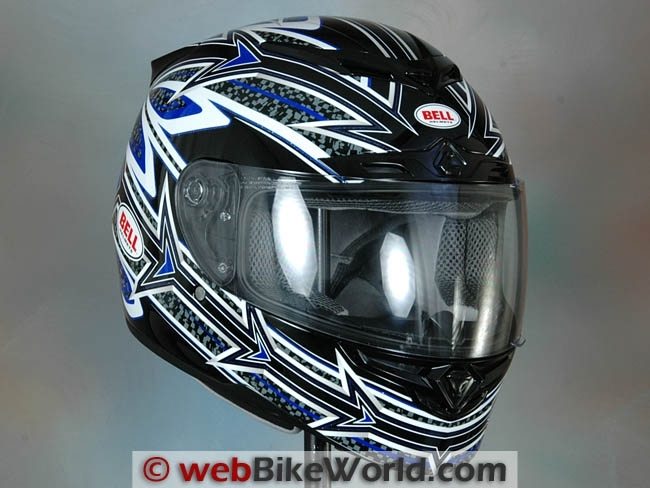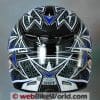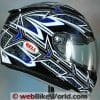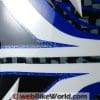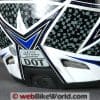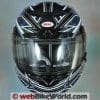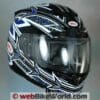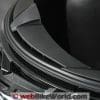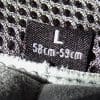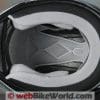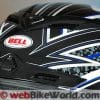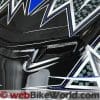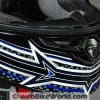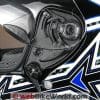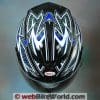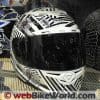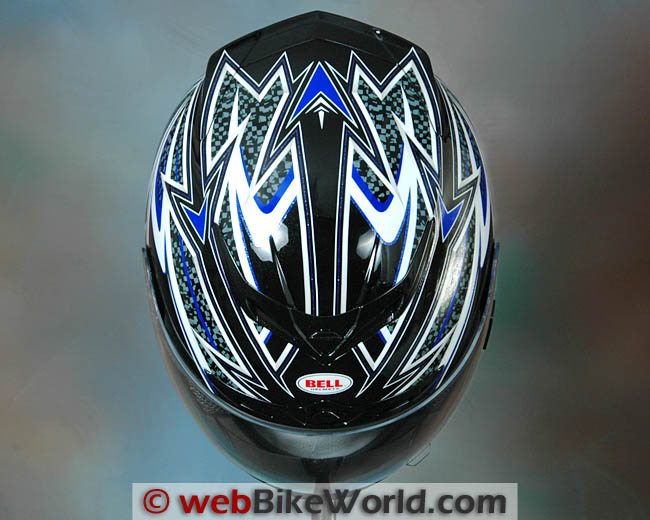The RS-1 rings the Bell (sorry!), with outstanding quality, modern design and a leading-edge feature set.
Factor in the super-plush, very comfy interior, excellent ventilation and superb noise control for a hard-to-beat combination and a very good value.
The RS-1 also meets both DOT and Snell 2010 safety standards.
The internal shape of the RS-1 is on the narrow side of neutral and the Bell apparently uses a non-standard sizing scheme for this helmet, so be sure to read the fit and sizing section below.
The revival of the Bell brand over the last several years has been remarkable.
The company now has a reputation for providing leading-edge features, clever engineering (3Mode face shield; Quick Release; Magnafusion retainer, etc.) and lots of bang for the buck with their helmets.
The RS-1 is the latest in the Bell Helmet series for 2011.
And while it may not quite match the ultra-value proposition of the Bell Arrow (review) and Bell Vortex (review) pair, the RS-1 is a superb helmet for the money and it beats a few much more expensive helmets at their own game.
The Bell RS-1 fills the niche between the top-of-the-line Bell Star (review) and the value-priced Bell Vortex (review) in the Bell lineup. The Star can now be considered as the company’s full race helmet, while the RS-1 is sort of a street/sport helmet with racy intentions.
This is good news and bad news for Bell, because the RS-1 offers nearly all of the features and goodness of the Star but costs $200.00 less.
So unless there’s a jacked-up 2012 Star on the horizon, it’s hard to justify spending more to get…not much more!
The Bell RS-1: Paint, Graphics and Overall Quality
Bell is also known for exciting color designs and the RS-1 is available in a small but interesting array of solid colors and graphics.
The blue “Victory” graphic on the helmet in these photos is very nicely done and it even has a bit of a texture with the thick silver metalflake lines outlining the arrows in the design.
The Victory graphic is also available in red. Two more graphics are available; the black/white “Shattered” and the matte black/white “Panic Zone”, both of which are pretty far out and pretty cool-looking too.
The Victory graphic acts as a camouflage for the overall shape of the RS-1. The shape is somewhat reminiscent of a Bell Star with the volume turned down from 10 to 8. The solid colors — especially the silver — make this more apparent.
The surface is coated with a high-quality, nicely applied, thick-feeling, high-gloss clear coat that should provide good protection through years of use.
The RS-1 oozes quality, from the outstanding liner with its oh-so-soft micro-fleece lining and thick padding to the equally outstanding Bell 3Mode face shield with its micro-click adjustment system and slick-as-silk Quick Release removal system.
These features are also found on the top-of-the-line Bell Star, so if you’re losing anything by spending less for the RS-1, it’s not apparent (although you don’t get the cool helmet bag that comes with the Star!).
While the vents may not have the tight snap-open feel of an Arai Vector 2 (review) and they’re perhaps not quite as easy to find when wearing gloves, overall it’s a minor issue and the strong ventilation more than makes up for it.
So overall there’s nothing to complain about in the quality department and there’s lots to like. The RS-1 feels more upscale than the Bell Vortex or Arrow but it does cost about twice as much.
The flip side is that you’re probably getting a $500.00 helmet for $350.00, certainly a good thing in my book.
Score: I’ll give the Bell RS-1 an “Outstanding” rating for design, paint and overall quality. See the Summary Table at the bottom of the page for a description of our rating system.
Bell RS-1 Helmet Fit, Internal Shape and Liner
Bell has apparently settled on a “European” style internal shape for their higher-end helmets that is slightly outside the norm; that is, the Bell fit is not “Neutral”.
Both the Star and now the RS-1 have an internal shape that is generally similar to Shark and Nolan helmets, for example, and perhaps even the SCHUBERTH C3 (review).
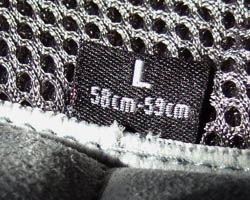
The RS-1 fit is classified as the webBikeWorld “Slightly Narrow” type, with narrower sides and top.
I’ll rate it as not quite as narrow as an Arai Profile (review), but narrower than an Arai RX-Q (review) or the Bell Arrow (review).
It also fits similar perhaps to the Scorpion EXO-700 (review) or the new Arai Vector 2 (review).
It’s important to note that there is a discrepancy with Bell’s size chart for the RS-1, which lists the size large RS-1 as a 59-60 cm, which is a standard size large for a motorcycle helmet.
Going by the size chart, I initially ordered a size large, but when it arrived, I was surprised to find that it is labeled as a “L 58-59 cm”, which is a non-standard size for a large.
The only other company I am aware of that uses this non-standard sizing for a large is Schuberth, as detailed in our SCHUBERTH C3 review.
I can confirm beyond doubt that the size large RS-1 we received is definitely not a 59-60 cm. A photo of the label is shown above and you can see it’s listed as 58-59 cm. This is contrary to the Bell size charts and the size charts used by the various retailers.
So before you buy an RS-1, check to make sure you are indeed getting the size you require and make sure you try before you buy.
[UPDATE: In response, Bell said the original manufacturing run used the 58-59 cm size large and the size has now been changed to 59-60 cm for a large.So you may want to confirm which size your retailer has in stock before placing an order.]
Now it’s possible that we have a one-off, weirdo size large RS-1 that was made to fit a 58-59 cm head, but I doubt it. And it isn’t mislabeled, because the fit is definitely not a 59-60 cm, which would fit me because that’s the size I usually wear.
Once you’re past these sizing quirks, if your head shape matches the internal shape of the RS-1, you’re golden. The very cushy padding and super-soft micro-fleece lining material makes the RS-1 one of the most comfortable helmets ever.
I ended up ordering an XL and although it isn’t quite a match for my round head shape, there’s enough padding in the sides to keep it comfortable.
In fact, overall the size XL feels great, but I can slip two fingers easily up along my forehead when wearing the helmet, a sure sign of a mis-match between my round head shape and the narrower internal shape of the RS-1.
This isn’t a problem in terms of comfort with the RS-1, but that much of a space means that there may be a safety issue for me.
My head will use the distance to accelerate before it hits the padding if I go down, so the helmet may provide sub-optimal protection for me. Too bad, because otherwise the helmet feels great.
The RS-1 has deep ear pockets with a thin section of lining covering what feels like a cutout in the EPS for a speaker. There are rumors of Bell striking a deal with one of our favorite intercom manufacturers to provide an OE system, so we’ll see.
My cut-down eyeglasses fit when wearing the RS-1 but I’m not able to hook my regular eyeglasses over my ears when wearing the helmet. So just like it is on any helmet, fitting eyeglasses will vary, depending upon head shape and eyeglass type.

More information on helmet fit can be found in the webBikeWorld Motorcycle Helmet FAQ page, along with the chart that lists the helmet weights of webBikeWorld reviewed helmets and also by shape on the webBikeWorld Motorcycle Helmet Shapes page.
Score: I’ll give the Bell RS-1 an “Outstanding” rating for comfort and liner materials and padding. Check the fit to make sure it works for you before buying; round heads may not fit.
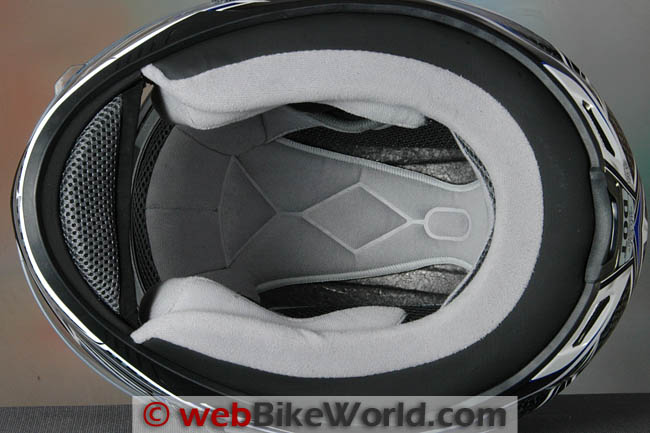
Bell RS-1 Face Shield, Eye Port and Visibility
Then the shield lifts through a series of fine micro-clicks as it’s raised. The system has a low-effort and high-quality feel.
Removing the face shield couldn’t be easier; it’s the same system used on the Bell Star. Pull the lever, the shield pops out. Bell should have patented this system and licensed it to other manufacturers.
The face shield is 2.20 mm thick and it’s marked as meeting the VESC-8 standard. Although the Bell website doesn’t say whether it’s treated with their “NutraFog II” (what a name) anti-fog coating, that feature is listed on the hang tag that came with the helmet.
The weather is too warm to give it a workout, but it seems to help prevent fogging.
Visibility out the eye port is good; I’d rate it as average to slightly better than average, both in the horizontal and vertical planes, when compared to other helmets.
The face shield on both the L and XL helmets does not seal completely against the eye port gasket. There’s a slight gap across almost the entire top, so it does leak water. The gap doesn’t change when the face shield is locked down.

Score: I’ll give the Bell RS-1 an “Outstanding” rating for the overall quality and operation of the face shield, while the seal along the top of the eye port gasket and outward visibility rate a “Very Good”.
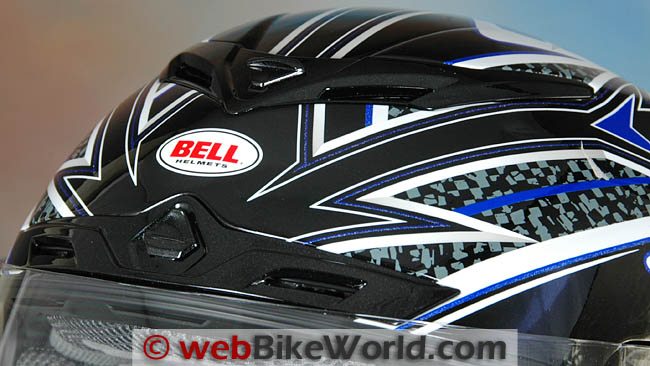
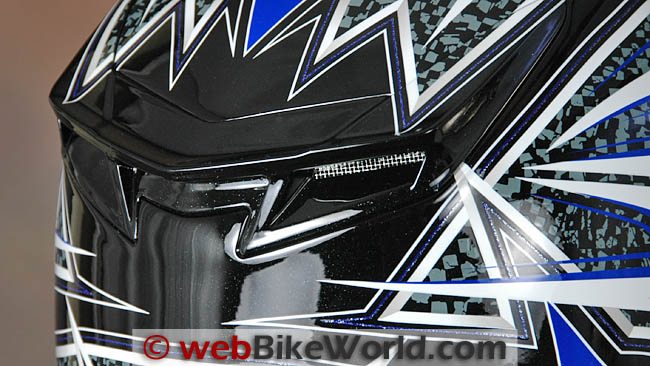
Bell RS-1 Ventilation and Air Flow
The RS-1 has a nicely designed venting system consisting of a brow vent, a top vent and a chin vent that flows air directly through the chin bar.
The entire system works well and the ventilation is better than average but I believe it has some untapped potential to be much better than that.
The problem is in the design of the liner, which covers the intake ports in the EPS and blocks a certain amount of air flow. The EPS does include two shallow molded channels, which pass some of the air, but much of the air flow is blocked by the liner material.
The thick crown completely covers the brow ports that enter through the EPS, making it difficult to tell the difference whether the brow vent is open or closed.
I’m almost certain that with a more open type of liner with mesh around the vent ports that the air flow in the RS-1 would be dramatically increased.
It is possible, however, that a redesign might affect the comfort provided by the existing design, so there’s somewhat of a tradeoff here…but I feel confident the Bell designers are up to the challenge.
The chin vent has no such problem; it flows a large volume of air through two large vertical ports cut directly through the protective material in the chin bar.
These ports are located on either side of the mouth, and there is definitely a difference in air flow that can be felt with the chin vent is open or closed.
The large chin curtain is padded on the underside, which adds to the comfort factor and helps direct the air from the chin vent to the rider while blocking most of the air that normally flows up from underneath the chin bar.
The exhaust vents are always open and are covered by a small spoiler at the upper rear. Two more large exhaust vents are located towards the bottom of the helmet shell in the rear.
So overall, the RS-1 gets excellent marks for air flow but I think with a bit of redesign on the liner, this could potentially be raised to “Outstanding”.
One note on the liner material, it feels very comfortable and plush but I did notice on one day of riding in 73 degree temperatures that my head felt sweaty, so perhaps the very thick and plush material isn’t as absorbent as it could be.

Score: Even with the issues noted above, I’ll give the RS-1 an “Excellent” rating for upper ventilation and an “Outstanding” rating for chin venting.
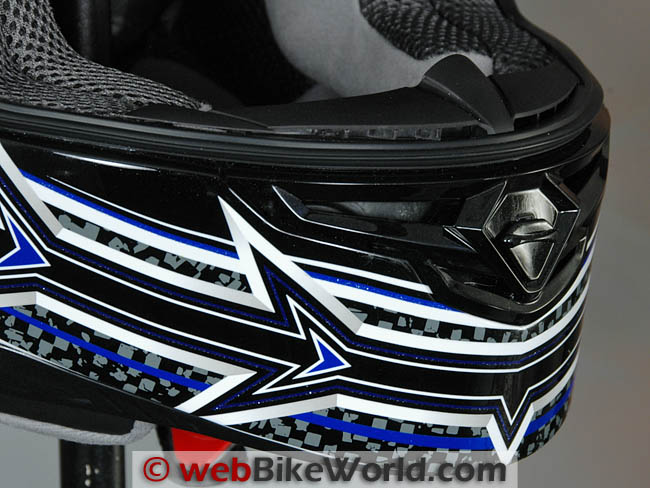
Bell RS-1 Noise Levels
I have been quite amazed at how ell the RS-1 controls noise levels. It may be due in part to the liner material covering the upper vents, or perhaps the thick, cushy liner padding helps. The thicker Snell 2010 shell may also help deaden the noise.
In any case, the helmet is much quieter than I expected under a variety of conditions and different types of motorcycles.
It’s especially noteworthy because the XL helmet is slightly too large for my head, especially around the top, with the “two finger” gap at my forehead noted above.
This usually causes an increase in noise because of the air space between the padding and my head, but it just doesn’t happen on the RS-1.
In fact, I’ll go as far as saying that the RS-1 is one of the quietest helmets I’ve worn. Note, of course, that this is all relative — riding a motorcycle with a helmet is a very noisy endeavor and I always wear ear plugs.
The helmet does seem to be slightly louder around the bottom, although this may be due to the size XL factors noted above. Also, the wind noise is so subdued that I can hear engine and exhaust noises when riding that are not apparent when wearing other helmets.
The overall shape of the helmet does an excellent job at slicing through the air and I notice no problems with lift or buffeting, also unusual considering the size issue.

Note that our helmet evaluations are a combined effort of several riders over time on different types of motorcycles with and without windscreens.
Evaluators wear correctly fitted, high quality ear plugs (even when evaluating motorcycle intercom systems).
Always protect your hearing when riding a motorcycle. See the wBW Earplug Reviews for more information on choosing and wearing earplugs.
Note also that perceived noise levels will vary, depending on the individual.
Noise can be caused by many factors, including helmet fit, the type of motorcycle and windscreen, wind speed and direction and even the rider’s clothing.
For more information on helmet noise, visit the wBW Motorcycle Helmet Noise page.
Score: I’ll give the Bell RS-1 an “Outstanding” rating for better than average noise control.
Helmet Weight
Bell touts the “lightweight Kevlar/fiberglass shell” of the RS-1 and the shell composition is one of the differences between the high-end and lower-end Bell helmets.
But the Snell 2010 approval has added some weight, as it usually does. The size large RS-1 weighs 1603 grams (3 lbs., 8-1/2 oz.), while the size XL weighs in at 1644 grams (3 lbs., 9-7/8 oz.). This is good, but not outstanding.
Helmets in these weight ranges include the Arai RX-Q (review) (L) at 1597 grams and the Shark RSR (review) (XL) at 1601 grams.
Also the Osbe X-Race (review) (XL) at 1601 grams; the SCHUBERTH C3 DOT (review), a flip-up in size L at 1603 grams, the Shoei X-Eleven (review) (XL) at 1635 grams and the Shoei Qwest (review) (L) at 1648 grams.
Note also that all of the helmets reviewed on webBikeWorld have been weighed and the weights are available on the wBW Motorcycle Helmet Weights page, along with a chart that lists the helmets by weight and shape on the wBW Motorcycle Helmet Shapes page.
Score: I’ll give the Bell RS-1 a “Very Good” rating for its reasonable weight and its good balance.
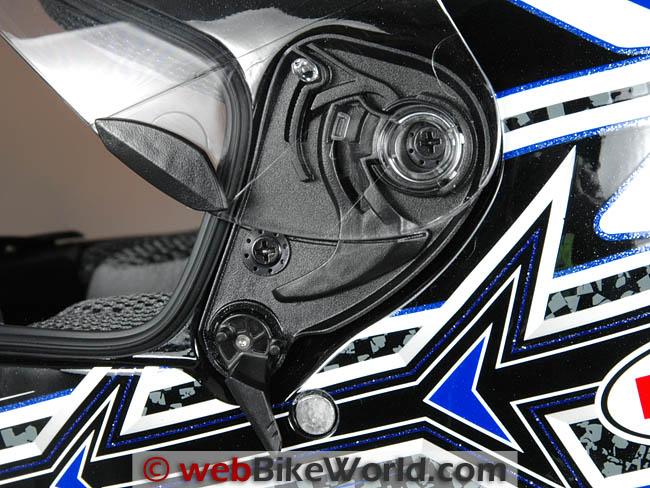
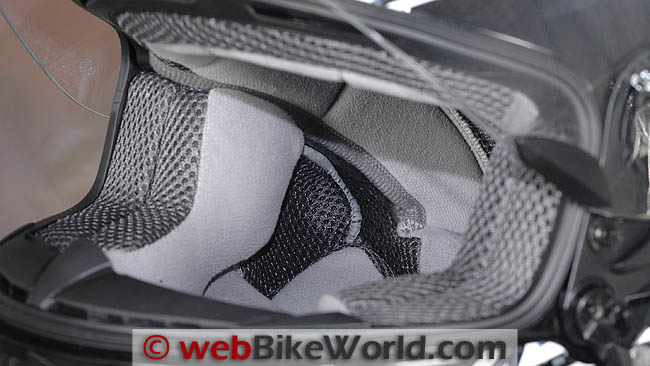
Miscellaneous
The Bell RS-1 has a double D-ring retainer system and the Bell “Magnafusion” magnetic chin strap retainer and it works very nicely.
Bell offers a five-year warranty on the RS-1. The expected life of the helmet is 5 years, so this should cover any problems during that time frame.
The helmet is labeled as meeting the DOT safety standard and it is Snell 2010 approved. The RS-1 is apparently sold only in North America.
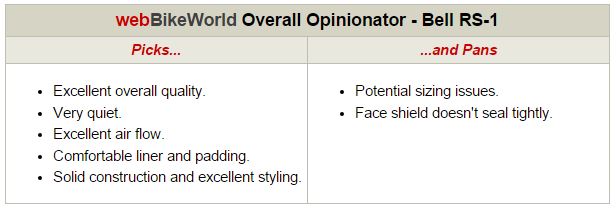
Conclusion
The Bell RS-1 is another winner; it’ more comfortable than the Bell Star and it has a softer interior with a plusher lining. T
he fit is to the narrow side of neutral, so it may not work for as many head shapes as other Bell helmets, but if you find a size that fits and the shape matches your head, you’d be hard-pressed to find a better helmet at this price.
| wBW Product Review: Bell RS-1 Helmet | |
|---|---|
| Manufacturer: Bell Helmets | List Price (2011): $349.95 to $399.95 |
| Colors: Solids and graphics. | Made In: China |
| Sizes: XS-2XL Shell Sizes: 2 (Unconfirmed) | Review Date: May 2011 |
|
Rating Scale is subjective: Unacceptable, Poor, Neutral, Very Good, Excellent, Outstanding.
|
|
Owner Comments and Feedback
See details on submitting comments.
From “R.A.” (April 2014): “Love your reviews! Buying a RS-1 this week. In response to Ian Smith’s review comment (below) regarding “who” Corsa 54 was, it represents Bell Helmet’s first year of manufacturing, 1954.
Keep up the excellent work! You THE best resource for moto gear information. Thank you!!!
By the way, the reason I am buying a RS-1… I had been wearing a Shoei RF-1000 (review) for a few years and recently replaced it with a near-new RF-1100 (review) I purchased from a friend.
As comfortable and well-fitting (and well made) as the 1100 is, it is significantly louder than my 1000. Seems to buffet more as well. Even my close-out $50 HJC CL-16 (review) is quieter and smoother!
Very disappointed as I have worn Shoei helmets (and ear plugs!) since the late ’70’s (S-12). Every consecutive model of the RF-series I have owned was better than the last until this one. I have heard comments that the Shoei RF-1200 (review) is even worse.”
UPDATE From “R.A.” (May 2014): “I purchased my 2XL Airtrix Speedway model from an online retailer. Though the sizing chart indicated an XL would have been better, the 2XL was not only crazy cheap, no one had an XL of this scheme in stock.
I did some research, spoke to a Bell customer rep, and confirmed that the 2XL and XL share the same shell size and only differ in the replaceable liner and cheek pads.
The 2XL was so cheap, I also ordered an XL liner and pads, and it was still cheaper than other RS-1 color schemes.
Upon receipt and first inspection of the lid, I was very impressed with the overall quality of materials and paint/graphics (as pointed out in your review). At least as good as my Shoei RF-1100 (review).
After swapping out the liner, I found the fit to be perfect, even with the pads that came with the helmet, so I sent the ordered ones back. The innards are really easy to remove and replace.
So how did it perform on the road, you ask? Very well! Quiet and smooth.
Though I didn’t feel significant airflow from the top vents, I can feel a slight cooling of the sweat on my forehead from the brow vent. With the RF-1100, I know the vents are open…not only can I feel the airflow, there is a distinct whistle.
Visor operation is not quite as nice as the Shoei (the first detent on the RS-1 is just the right amount, but isn’t as secure as the first one on the RF-1100).
I measured the weight at 3 lb., 9.5 oz., with the RF-1100 at 3 lbs. 14.5 oz. (my XL RF-1000 came in at 3 lbs., 9 oz.).
My overall impression of this helmet matches yours: outstanding value! Consider that “older” graphics can be had for well under $200, this is THE performance helmet bargain.
One purely subjective opinion is that the Shoei feels more “substantial” (not necessarily heavier, just a hard to quantify feeling). But all in all, the RS-1 lacks nothing on the RF-1100.
The only negative comment I can make is that I do not like the magnetic tab to hold the chin strap…
I would prefer the more substantial snap (this is a personal preference). I will continue to use both helmets, but when it comes time to replace again, my first choice will be another RS-1.”
From Ian Smith AFM# 421 (April 2014): “Just wanted to say thanks to you and webBikeWorld. I always head over before I purchase anything motorcycle related. What I’m looking for may not always be reviewed, but I do check first.
I just purchased the Bell RS-1 based heavily on the in-depth review you did. Went to a local shop and tried it on. Very nearly picked up one but wanted to compare to the HJC FG-17 one more time and they didn’t have one there.
Plus only had black or white, want some flash since this is to replace my Shoei X-Eleven racing lid.
The Shoei no longer qualifies for the local racing Club, the AFM, because of its M2005 rating. Thought the Bell or HJC would be big step down but after putting on both I’m not so sure now.
After trying on both once again and walking around in them I deiced on the Bell. Walking around outside, it was just a bit quieter. Not a real world test but its all I could do at the time.
The shop told me of a big helmet day on the 26th, plenty of time before the next race, so I decided to wait. Looked at webBikeWorld one more time later that day and clicked on one of your (affiliates) to see what they had. I am so glad I did!
There it was, a super sale on the Corsa RS-1! And they had a medium. Now I just have to figure out who Corsa 54 was. Not Troy, he was 11…oh well, it’s red, white and black — it will work. Race report to come.
Next round will be at Sears point (Sonoma now) with some AMA in attendance on May 4.”
From “B.” (November 2012): “I have an old Arai Corsair RX7 that is up for replacement any day. Back around Easter, I bought a Bell RS-1 from a local dealer. That helmet initially blew me away as a tremendous value.
The liner felt great, ventilation was solid, and overall quality impressed me. It didn’t feel like a step down from a $700 helmet and that’s amazing.
That made it all the more disappointing when I had to return it. My RS-1’s stock shield and smoke shield both exhibited mild visual distortion. Specifically, there was a vertical line of distortion 1-2″ to the right of center and another 1-2″ to the left of center.
With both eyes open, it wasn’t readily apparent to me.
It caused an infrequent sense of “something is… strange” that I couldn’t pinpoint and discomfort in certain situations.
Such as sections of road with a lot of tar snakes running perpendicular to the direction of travel. When I closed one eye and looked around, though, the distortion was easy for me to pinpoint.
I went back to my local shop to report the issue and multiple staff members verified my claims once I told them just where to look. We tried several alternative shields. Bell offers two types of shields, standard and race.
The standard shield curves in two directions, side to side and top to bottom, while the race shield is flat top to bottom. The distortion was less evident on the race shield, but still there.
Unfortunately, I couldn’t un-see it. We went through at least six shields, even attaching them to other Bell helmets, before I gave up.
To Bell’s credit, they quickly partnered with the dealership to accept the return and refund my purchase price. So, their customer service was fantastic.
Maybe I’m just spoiled by my Arai shields, which don’t exhibit the problem. Either way, I’m particularly sensitive to it and it is a minor but noteworthy issue. Case in point, my fiancée’s Icon Alliance has a similar distortion, but she doesn’t see it.
If I had faith that the problem would be resolved any time soon, I’d pick up another RS-1. Sadly, I’m right up against five years on the Corsair, so there’s no more time to wait.”
From “J.A.” (May 2012): “The RS-1 replaced my Shoei RF-1000 after a deer took me out in February and I did my research and checked your website of course. I went with the RS-1 based on airflow since its really REALLY hot down here in Texas.
The thing about good airflow is that it also allows the no-see-em’s (bugs) into your private atmosphere. One other note is that I wear a Large in Shoei’s RF series, but had to upgrade to an XL in the RS-1 because it is REALLY tight.
I’ve been riding (and sweating in it) for 3 months now and its quiet, with great aerodynamics for doing over the shoulder lane checks.
One thing I will note is that in the rain wearing a Shoei, I could turn my head left and right and use the wind to wipe the water from the shield (flat).
On the RS-1 the shape of the shield (bubbled) or the aero or something doesn’t create the same beading/push affect so I’ll have to find another way to clear the water from the view.”
From “G.S.” (March 2012): “You mentioned that the original run of the RS-1 had a non-standard sizing, but that Bell was changing this for future runs.
This still seems to be an issue, as I have now bought (and returned) two RS-1s, both of which were had a sewn in label of “L(58-59)”. These were from two different (retailers).
As a last resort, I tried Bell’s direct shop, but after talking to their customer service, they couldn’t tell me which one I’d get, although their site shows L as 59-60. The lady on the phone told me both sizes were “correct”.
The one I tried on at the motorcycle show was marked as 59-60 for large, and the XL was too loose. I’m not sure what numerical size it was.
At this point, I’m going for a Shoei Qwest. Hopefully Bell gets this worked out, as I liked the helmet and would have kept it had it not been for the size problems.”
From “S.Z.” (August 2011): “I should say this review is post-mortem. I bought a silver RS-1 a while back. Then a texter rammed into me from behind at about 40mph without braking at all and shoved me into the truck in front of me. My beloved 2006 Honda Interceptor was crushed like an accordion.
My Bell RS-1 actually did fairly well. I had a black eye, a bloody nose, a slight limp of the right leg, and a swollen jaw for a couple weeks (probably my glasses).
The rear spoiler popped off, the visor seal tore a bit, there are a few scratches and gouges, but even my photochromatic visor survived with minimal scratches and I use it to date on my Bell Torn Vortex (yep, I have them all!).
The fit of the size medium (all my Bell’s are size medium) was perfect. I thought my Bell Star was perfect. I now know it’s comfy, but loose compared to the RS-1.
The Vortex is comparable to the RS-1, and IMO it’s a better buy. I agree with you that the brow vent on the RS-1 is simply confusing. I can feel air diffusing inside the liner at the brow instead of flowing freely. The Vortex vents just as well for a heck of a lot less money.
By the way, the cheek pads from the RS-1 fit the Vortex. The headliners are different though.
Paint on my Gold Torn is excellent, The helmet solid. No QA issues at all. Go figure the cheap one in the lineup has no problems! If it was as quiet as the RS-1 I’d not think twice about not getting another RS-1.
The Vortex is a bit louder than the RS-1, but fit is identical. Probably the cheek pad/liner materials.
Comparing the Vortex cheek pad to the RS-1, the RS-1’s is thinner, but much denser than the Vortex’s. Same to be said for the headliners. RS-1 is thicker.
But I only paid $99 for the Vortex, and it fits identical to the RS-1.
I surmised as much since they both use a neck roll. I bought the Vortex just to see if i could swap liners and cheek pads, betting the fit would be the same. I bet they are the same shells, but the brow vent holes are different in the EPS. Neither works though.
The cheek pads on the RS-1 curl upward under my earlobes as I put the helmet on. I put a finger in the helmet and pull them down flush. No biggie.
The helmet is very quiet. Quietest of the Bell lineup. I had no trouble riding at 80-90mph on the highway and listening to my iTouch music. I have to say though that my Scorpion EXO-700 is just as quiet if not a tad more-so.
Right out of the box the visor crack/lock lever on my RS-1 flew off in my hand. It’s entirely plastic and not anchored to the face shield plate like the aluminum ones on the Stars. I notified who I bought it from and they had Bell send me out the left side plate from a Bell Star. Luckily, I have 3 Bell Stars.
They didn’t send me the right side, so I had black screws on the RS-1 and billet aluminum on the left from the Star replacement.
They are going to have a lot of complaints for going cheap on that mechanism, especially for $350 for a solid (which I noticed right away had some blotchy spots in the paint, along with noticeable paint touch-ups on the plastic top vents). Again, a QA problem.
Vents – no whistling noises. Again, a very quiet helmet.
The neck roll sticks out below the helmet, even in your video. You’d think this would actually add to the noise level. Maybe it does and maybe Bell should just go with a denser bottom on a normal cheek pad design.
I don’t know about that one. Maybe it’s a good insulator between the cheek pads and makes for a good sound deaden-er.
Again, I am not a fan of the magni-confusion chin strap system. There was nothing wrong with the older versions Bell used on my Stars. I like a snap.
Even reviews of the early releases mentioned that they had to beef up the magnet. I say get rid of it. End of problem.
Will I buy another Bell RS-1 to replace my destroyed helmet? I am on the fence on that. I want to try the Shoei Qwest (fit was as good, if not slightly better, as the RS-1), or even the Shoei RF 1100.
You say the Qwest is very quiet, but you also mention that paper tearing noise from the vents, and the fact that your head got warm on top at times.
My head never got warm in the RS-1 here in the high 90’s in Florida and the high humidity. I fear the Qwest will sweat me unless I am on the highway. The RF 1100 I’d like to try in the pure orange. Maybe someone will see me before they rear-end me again…. maybe. But of the RF 1100 you say the noise level is even worse and whistling from the vents evident.
Frankly, I am honestly a bit shocked that you all voted the Qwest as helmet of the year. Yet the Bell RS-1 has no issues with vent noises, fit, comfort, paint/graphics (at least according to your review), and best visor mechanism in the business.
Not to mention the photochromatic visor ending the need to ever carry a spare. What gives with that???
So, yeah, I’ll probably buy an RS-1 again. This time in a large (size 23 head right in the middle) and see if it vents as great as they say and if it was my head was just too snug in the helmet. Can that be possible? Too snug, but comfortable all day?
Anyway, that’s my gist on the Bell RS-1. Overall a decent helmet.
Photochromatic lens is the best thing since sliced bread. I’m 50 y/o now and they tried twice in the past 6 years to kill me. Good gear saved me and cost them a small fortune. I replaced the Interceptor with a 2011 Kawasaki Ninja 1000, with bags and heated grips.
This bike’s a monster! It’s what Honda should have done with the VFR 800 but instead bloated it out to the VFR1200 which I see sitting on showroom floors now, in pairs!”
Editor’s Note: The Shoei Qwest was a 2010 helmet and the Bell RS-1 was reviewed in 2011, so it wasn’t under consideration as a 2010 Product of the Year.
UPDATE From “S.Z.” (October 2011): “Well, you may remember that I had previously owned an RS-1 in silver in size medium. I lambasted its quality of construction and paint finish. I adored the fit. I was not getting the airflow that everyone was raving about.
I have to say that the Cataclysm I un-boxed is stunning. Not a flaw in paint or graphics to be seen. Let me tell you, that’s high praise. I go over my purchases with a fine-toothed comb.
In size large the fit is ever-so-slightly relaxed from the size medium I previously owned.
The shape is consistent in both sizes. It slips on slightly easier but still has a snug fit. The cheek pads no longer curl up behind my ears when I put it on.
I put my photochromatic shield on it and took a 3 hour ride to visit my brother in Cocoa Beach (Titusville really).
Venting was much better in the large size than my previous medium choice. Remember, I am borderline at 23”. I feared I was going to be returning this helmet for a size medium, but rest assured that will not happen.
I am very pleased with this helmet so far.
Oh, the visor lock mechanism has not popped off so far, but I have plenty of Bell Star parts to remedy that if it should happen.
At 70mph – 80mph+ on my 2011 Ninja 1000 with the screen in ‘race mode’ the helmet starts to push the head back (very clean airflow).
Put the screen up in ‘touring mode’ and that forehead pressure is gone, but the turbulence hits at the neckline with a more pronounced booming – a trade-off for most quiet vs. non-buffeting, but the touring mode is what I preferred.
Either way the helmet is still pretty quiet compared to any I have previously owned.
My Scorpion EXO-700 displays the same traits of pushing back on the forehead and face at higher speeds.
My Bell Stars do not exhibit this trait as the airflow is much better and the venting out of the helmet is key – but there is the extra noise from wind factor with that model.
I put my size 40mm cheek pads from my previous medium RS-1 on the size large RS-1 I now own to see if there was any difference in noise levels (large comes with 35mm). Honestly, I can’t really say that there is.
The helmet is quiet as is though. That’s one of the two reasons I dared to buy another RS-1. The other was that I was praying that the fit was just as good, and it is. I still have a set of 45mm pads on order and hoping to get them Tuesday (tomorrow).
I put my U-Clear Bluetooth (review) speakers and control unit on the helmet when I got home Sunday. It’s pretty decent up to about 70mph for music, but it can’t really compete with earbuds (Sena has that option, but it is a much bulkier unit, and you have to have room for a boom mic.).
Riding to and from work though it should do fine.
I will say that I can hear wind noise that the U-Clear generates on the side of the helmet and I can only imagine a bigger unit like the Sena would produce even more noise on the left side, but the ear bud option would discount that I am sure.
For anyone that may ask about speaker placement in the Bell helmets I say this; Do yourself a favor and buy the speaker foam kit for the Bell Star. It will fit any of the Bell Vortex, RS-1 and Star models. Another point is to not take out the foam.
Leave it in so the speakers are closer to your ears. The speakers for most communication devices have the Velcro around their speaker circumference and it grabs the foam nicely.
That, and the fact that the cheek pads have a flap that cover the speakers, actually holding the speakers in place if you mount them on the foam.
If you’re paranoid that the speakers might move slightly, then apply the supplied Velcro onto the top of the foam!
There is enough speaker wire to actually put the wires in the EPS and put the neck roll on with the wires coming out nice and flush between the neck roll and shell.
I would do this set-up with any comm system out there regardless of having a boom mic or not. A very nice custom looking setup.
Yes, the bulk of the wire still goes behind the headliner in back.
I am simply saying that you can tuck the wire from the left ear in the shell and have it come out between the neck roll and shell and not over the neck roll, which in my opinion creates an air gap in the neck roll and allows for more wind noise inside the helmet. Is that clear enough?
Oh, I also used the clip and not the tape mount to the shell. I mean, who the heck wants to tape anything to their helmet? Tape wears out over time, and any riding in the rain will just accelerate that deterioration.
Again, kudos to Bell on this helmet. They have redeemed themselves in my eyes.
I now have in my collection the Cataclysm RS-1, the Gobert and Recoil Stars, the Livin’ Large Star (separated because it is post 2010 fitment adjustment), the Vortex Gold Torn, and the Scorpion EXO-700 Chameleon black.
I imagine still that my favorites will, and are, the RS-1, the Scorpion, and the Bell Livin’ Large… in that order. The Star is for in-town and the Florida summer, the RS-1 is for everything else except – the Scorpion is for rain.
It has proven itself water tight. The Stars, RS-1, and Vortex all leak at the top of the visor in heavy rain. The Scorpion, even with all vents wide open, never allowed water onto my head or through the front of the visor.
I ride in monsoons people, so take my word for it.
The Sol-FX visor for the Bells is unsurpassed for the fact that you never have to carry another visor ever again. The Scorpion is still the no-fog champ — period. The Sol-FX is very good though in that respect.”


